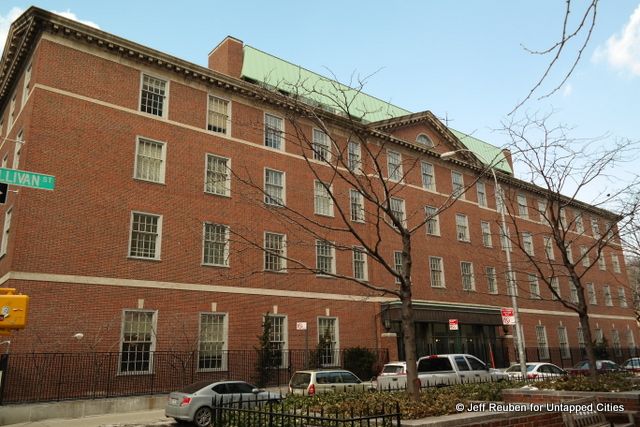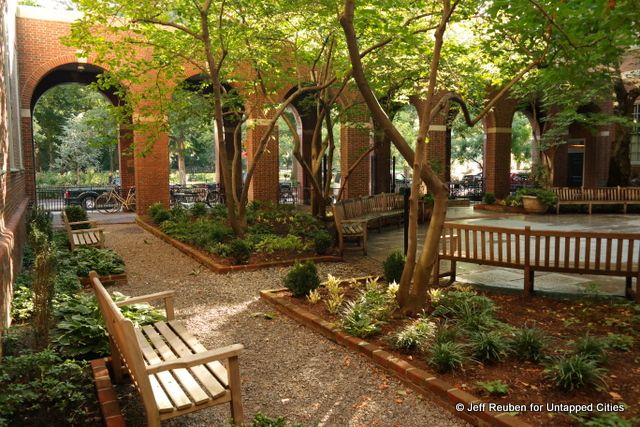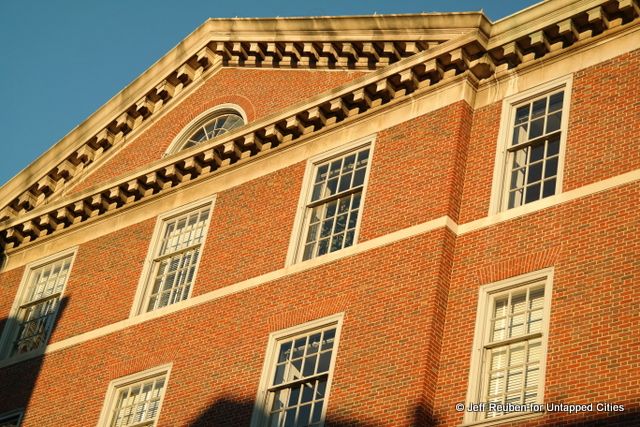NYC’s Forgotten ‘War on Christmas Trees’
Discover how an obscure holiday crackdown affects festive street vendors today!


With fall and the back to school season coming up, Untapped Cites is uncovering the hidden and little known past uses of some of New York City’s colleges. Today we look at Vanderbilt Hall, home of the New York University School of Law, located at 40 Washington Square South in Greenwich Village.
In the late 1940s when New York University announced plans to develop Vanderbilt Hall, a new home for its Law School, many local residents rallied to “Save Washington Square” from a project that they charged would debase the area’s character. In a case of history coming full circle, in 2013 historic preservationists hailed the inclusion of Vanderbilt Hall in the South Village Historic District.

In 1948, NYU purchased a full block property along Washington Square South from Columbia University and announced plans to construct a new Law Center there. The plans called for the clearance of all existing building on the block including a row of townhouses facing the park at 40 to 47 Washington Square South where many of the tenants were artists and writers.
At the time of NYU’s purchase, notable tenants included sculptor Jacques Lipchitz and the creators of Curious George, H.A. and Margret Rey. The Rey’s fondness for their home at 42 Washington Square South was reflected in their 1945 holiday card which featured an illustration of the building.
A local group, the Save Washington Square committee, strongly opposed the new Law Center. The building would be “destructive of the character of Washington Square” according to the group’s petition that reportedly had over 12,000 signatures. Their leaders urged NYU to build elsewhere in the Village.
Likewise, an editorial in the New York Herald Tribune argued that NYU would “ultimately destroy the architectural and cultural values of this celebrated district and seriously compromise its usefulness as a park.”
A variety of efforts to oppose the project including legal action only managed to delay it and by mid-1949 demolition of the existing buildings was underway.
NYU Law School Dean Russell D. Niles was dismissive of the project’s opponents. Writing in an academic journal, he observed, “the block was occupied by 160 tenants. They claimed to be artists, but they sounded like professional publicists. While all claimed that they needed strong north light, it is difficult to see why some of them wanted north light or, indeed, any light at all.”

“Vanderbilt Hall” copyright NYU School of Law. Image via Wikimedia Commons
Despite the acrimony, NYU did make some efforts at being contextual with other Washington Square area buildings. Vanderbilt Hall was limited to four and a half stories and was built in a neo-Georgian architectural style.
The new Law Center, named for New Jersey Supreme Court Chief Justice and former NYU Law School Dean Arthur T. Vanderbilt, was dedicated on September 15, 1951.
Of course, the story did not end there. Similar town-gown conflicts have arisen over a number of NYU projects, including another effort to “Save Washington Square” in the late 1990s and challenges to current expansion plans.

As for Vanderbilt Hall, with age it has gone from “destructive” to historic preservation darling. When the NYC Landmarks Preservation Commission decided to include it in the South Village Historic District, the Greenwich Village Society for Historic Preservation commended the move.
GVSHP noted that the building was “previously controversial” but that “once Vanderbilt Hall was built, locals came to appreciate the charms of the contextual, neo-Georgian structure,” attributing this to NYU being responsive to the concerns about the building design.

Next, read about the Top 10 Secrets of Washington Square Park and explore the nearby clocktower of the Jefferson Market Library.
Subscribe to our newsletter